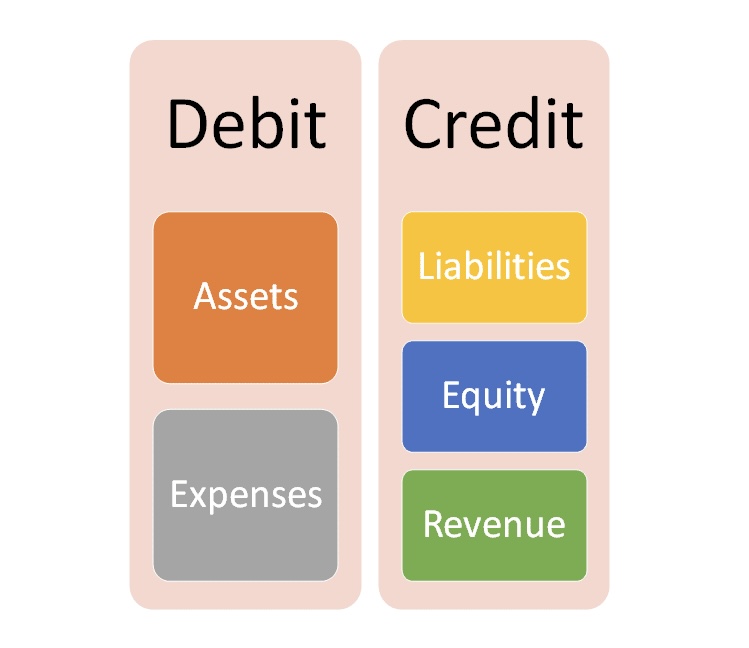Entries on a balance sheet are called debits and credits. Debits (DR) are for when you receive money, like a deposit. Credits (CR) are for when you spend money, like paying bills. How they appear on the balance sheet depends on what type of account they belong to.
Let’s delve into the definitions and examples of debits and credits to understand it’s basics.

What is Debit?
Debit is a fundamental concept in accounting and finance that represents the recording of an increase in assets or a decrease in liabilities or equity. Here’s a more detailed explanation:
In accounting, every financial transaction involves at least two accounts—a debit account and a credit account. Debit and credit entries are used to record these transactions in double-entry accounting systems, which are designed to ensure accuracy and maintain the balance of accounting records.
When a transaction occurs, the debit side of an account represents the left-hand side, while the credit side represents the right-hand side. Debits and credits are used to record changes in account balances, with specific rules governing which accounts are debited and credited based on the nature of the transaction.
In general, the following principles apply to debit entries:
- Assets: Debits increase the balance of asset accounts. For example, when a company purchases inventory for cash, it records a debit to the inventory account to reflect the increase in inventory assets.
- Expenses and Losses: Debits increase the balance of expense accounts and represent decreases in equity. For example, when a company incurs an expense, such as rent or utilities, it records a debit to the corresponding expense account.
- Drawings: Debits increase the balance of drawings accounts, which represent withdrawals of assets by the owner of a sole proprietorship or partnership.
- Liabilities and Equity Decreases: Debits decrease the balance of liability and equity accounts. For example, when a company makes a payment on a loan, it records a debit to the loan payable account to reflect the decrease in liabilities.
What is Credits?
In accounting, a credit refers to an entry made on the right side of an account. It represents an increase in liability, equity, or revenue accounts, or a decrease in asset or expense accounts. In simple terms, credits are used to record transactions that either increase what a company owes (liabilities), increase the owner’s stake in the company (equity), or increase income.
Here’s a breakdown of what credits signify:
- Increasing Liabilities or Equity: Crediting a liability account (such as Accounts Payable or Loans Payable) or an equity account (like Owner’s Equity) indicates an increase in the obligations owed by the business or an increase in the ownership interest in the business. For example, if a company takes out a loan, it credits the Loans Payable account to record the increase in liabilities.
- Increasing Income or Revenue: Crediting an income account (such as Sales Revenue or Service Revenue) reflects an increase in the earnings or revenue generated by the business. When a customer makes a purchase, the company credits the Sales Revenue account to record the increase in sales.
- Decreasing Assets or Expenses: Crediting an asset account (like Cash or Inventory) or an expense account (such as Rent Expense or Utilities Expense) signifies a decrease in the resources owned by the business or a reduction in the costs incurred. For instance, when a company pays off a portion of its outstanding debt, it credits the Cash account to reflect the decrease in cash assets.
Conclusion
At Santa Monica Accounting, we don’t just crunch numbers; we craft financial solutions that propel businesses forward. With a keen understanding of accounting principles like debits and credits, we ensure our clients’ financial records are not just accurate but also strategically aligned with their goals. Our meticulous approach means that whether we’re managing expenses or tracking revenue, every entry is meticulously balanced to provide a clear picture of your financial health. By harnessing the power of these foundational concepts, we empower businesses in Santa Monica and beyond to navigate complex financial landscapes with ease. With Santa Monica Accounting by your side, you can trust that every decision is backed by reliable data and a clear understanding of your financial standing. Let us be your partner in achieving lasting financial success.

Thank you for reading with SMA!
Seeking help with your bookkeeping and accounting?
We’re right here for you!
Cultivating Success: 10 Essential Small Business Tips
Starting and running a small business can be an exciting yet challenging endeavor. While the journey is filled with opportunities…
Budgeting Success: Expert Tips for Managing Your Finances Wisely
In today’s fast-paced world, managing your finances wisely is essential for achieving both short-term stability and long-term financial goals. One…
Bookkeeping Essentials: A Comprehensive Guide to Financial Organization
Effective financial organization is the cornerstone of any successful business. Whether you’re a small startup or a well-established company, maintaining…
From Dreams to Keys: Your Unforgetable Journey to Home Sweet Home!”
Welcome to a world where your dreams take shape, and keys become more than metal – they’re the gateway to…
Nurturing a Supportive Work Environment: Empowering our Employees
In the dynamic realm of business, employees stand as the driving force behind an organization’s success. They are not just…
Common IRS Problems Faced by Taxpayers
Tax season often brings a mix of anticipation and anxiety for individuals and businesses alike. While many successfully navigate their…
Navigating Financial Terrain: Unveiling Common Budgeting Mistakes
Budgeting is like a compass that guides you through the financial journey, helping you make informed decisions and achieve your…
Mastering Financial Balance: A Comprehensive Guide to the 50/30/20 Rule
In a world where managing personal finances can feel overwhelming, the 50/30/20 rule emerges as a beacon of clarity and…
Navigating the Path to Financial Growth: Crafting your Unique Investment Strategy
In the dynamic realm of finance, achieving solid and consistent growth requires more than mere chance. It demands a meticulously…
A Comprehensive Guide to Effective Budgeting
Budgeting is the cornerstone of sound financial management. A well-structured budget enables individuals and households to allocate resources efficiently, track…
Unveiling Effective Business Strategies: Paving the Way to Sustainable Achievement
In the evolving world of modern commerce, enterprises encounter a multitude of challenges and prospects. To attain enduring prosperity, the…
The Significance of Bookkeeping Services
In the dynamic industry of businesses, where complexities abound and competition is relentless, maintaining a firm grip on financial matters…
Mastering your Finance: A Comprehensive Approach to Effective Debt Management
In today’s fast-moving world, managing finances has become an essential skill for achieving both short-term stability and long-term prosperity. One…
How to Build Business Credit
Whether you’re launching a startup or already managing a small organization, understanding how to build business credit is a crucial…
Demystifying the Basic of Bookkeeping: Your Guide to financial Clarity
In the intricate dance of managing finances, bookkeeping stands as a crucial partner. In time demystifying the basic of bookkeeping…
A Comprehensive Guide to Understanding Obamacare
The Affordable Care Act (ACA), commonly known as Obamacare. This has been a pivotal and often debated piece of legislation…
Money-Saving Wisdom: The Art of Financial Mastery
In an era where fiscal prudence has become synonymous with resilience, mastering the art of money-saving has emerged as an…
Efficient Tax Planning: The Comprehensive Guide in Decoding Financial Success
In the intricate web of personal finance, few things are as certain as taxes. While Benjamin Franklin’s famous adage “In…
Small Business Strategies for Growth: Navigating the Triumph to Sustainable Success
The realm of small business ownership is a dynamic arena that demands a strategic approach to flourish and prosper. Whether…
Financial Health: 10 Strategies for Unlocking Financial Well-Being
Financial health is the state of your complete money situation. It encompasses everything from how easily you can manage your…
How to Enter a Journal Entry in Quickbooks?
Journal entries are essential for accurately recording financial transactions in QuickBooks. They play a critical role in maintaining financial records,…
What is the Financial Impact of Remote Work?
The work landscape has undergone a profound transformation with the rise of remote work, accelerated by technological advancements and global…
Tax Benefits of Investing in Retirement Annuities
Investing in retirement annuities is a strategic financial decision that offers significant tax benefits, making it an attractive option for…
What is Multinational Corporation?
In today’s interconnected global economy, multinational corporations (MNCs) play a pivotal role. These entities, defined by their operations across multiple…
Tax Implications of Divorce Settlements
Divorce is not only a personal and emotional process but also a financial one with significant tax implications. When couples…
What is Working Capital Management?
Working capital is a critical component of a company’s financial health, representing the difference between current assets and current liabilities….



























